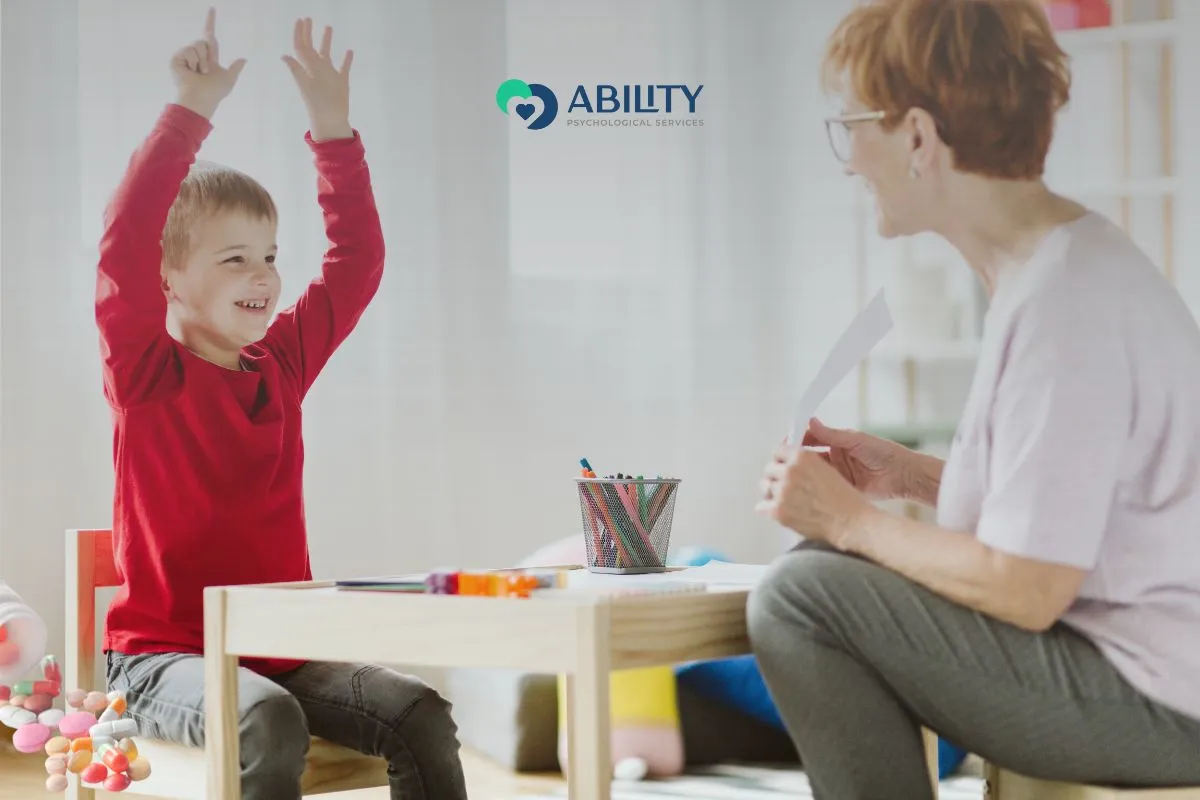Understanding autism specific services involves examining two crucial parts: An educational classification of ‘Autism’ and a clinical diagnosis of Autism Spectrum Disorder. In simple terms, an educational classification of ‘Autism’ centers around how a child’s educational needs are met within the school system, tailoring teaching methods to foster academic and social growth. It’s a practical approach employed by educators to support students with unique learning styles.
On the other hand, a clinical diagnosis of Autism Spectrum Disorder is provided via a formal process completed by a medical doctor or psychologist in order to figure out if an individual has an Autism Spectrum Disorder. This meticulous evaluation takes into account a person’s behavior, communication skills, and social interactions. Unlike the educational perspective, a clinical diagnosis is provided via a comprehensive assessment by a trained clinician such as a psychologist, medical doctor and/or a developmental pediatrician.
In this blog, our goal is to make these two parts of autism easy to understand. We want to show how they play different roles and why they matter. This is important for parents, teachers, and doctors to create a welcoming and helpful environment for individuals on the autism spectrum.
Keep reading because we’ll explain the differences between an educational classification of ‘Autism’ and a clinical diagnosis of Autism Spectrum Disorder, helping everyone approach autism with knowledge and kindness.
An Educational Classification of ‘Autism’ vs A Medical Autism Diagnosis

A clinical diagnosis of Autism Spectrum Disorder and an educational classification of ‘Autism’ are two distinct processes that play crucial roles in understanding and supporting individuals on the autism spectrum. Let’s break down the key differences between a medical diagnosis vs an educational classification of ‘Autism’.
A clinical diagnosis of Autism Spectrum Disorder is provided via a formal evaluation completed by healthcare professionals to identify and assess the presence of autism spectrum disorder. This comprehensive process involves observing and analyzing a person’s behavior, communication skills, and social interactions.
Trained clinicians, including psychologists and developmental pediatricians, use standardized assessments and observations to make an informed diagnosis. This clinical approach is essential for providing individuals with the necessary support and interventions tailored to their needs.
In addition, an educational classification of ‘Autism’ focuses on addressing a child’s learning needs within the school system. Educators employ practical strategies to understand and accommodate unique learning styles with the assistance of a school psychologist, often assisted by teachers and specialists, like speech pathologists.
This process is less about labeling and diagnosing a condition and more about creating an inclusive environment that caters to diverse educational requirements. Teachers collaborate with specialists to implement customized teaching methods, accommodations, and support services, fostering academic and social growth for students on the autism spectrum.
While a clinical diagnosis of Autism Spectrum Disorder is vital for identifying the presence of autism and guiding medical interventions, an educational classification of ‘Autism’ emphasizes creating an inclusive educational environment.
Both processes complement each other, ensuring a holistic approach to support individuals with autism in both healthcare and educational settings. Balancing clinical insights with educational strategies enhances the overall well-being and development of individuals on the autism spectrum.
Clinical diagnosis of Autism Spectrum Disorder

A clinical diagnosis of Autism Spectrum Disorder is a crucial process undertaken by healthcare professionals to identify and assess individuals on the autism spectrum. This formal evaluation thoroughly examines a person’s behavior, communication skills, and social interactions.
Trained clinicians, including psychologists and developmental pediatricians, employ standardized assessments and observations to make an informed diagnosis. During the clinical assessment, professionals carefully observe how individuals with suspected autism engage with others, express themselves, and navigate social situations.
They use established criteria outlined in diagnostic manuals, such as the DSM-5, to determine if the observed behaviors align with autism spectrum disorders.
The process may include interviews with parents, caregivers, or educators to gather comprehensive information about the individual’s developmental history and behavior across different settings. The goal is a holistic understanding of the person’s strengths, challenges, and needs.
A formal clinical diagnosis of Autism Spectrum Disorder is crucial for several reasons. It is a foundation for accessing appropriate interventions, therapies, and support services tailored to the individual’s unique requirements at home and in the community.
Additionally, it enables individuals and their families to understand better and navigate the challenges associated with autism, fostering a proactive approach to addressing specific needs. In essence, a clinical diagnosis of Autism Spectrum Disorder is an essential step toward providing targeted and effective support, promoting the well-being and development of individuals on the autism spectrum.
Is Autism a Medical Diagnosis?
Autism is recognized as a medical diagnosis, and the process of diagnosing autism involves a comprehensive evaluation completed by healthcare professional(s). Autism Spectrum Disorder is a neurodevelopmental condition characterized by challenges in social communication and behavior.
The diagnosis is typically based on criteria outlined in widely accepted diagnostic manuals, such as the DSM-5 or the ICD-10.
Healthcare professionals, including psychologists, developmental pediatricians, and child psychiatrists, play a crucial role in the diagnostic process.
They conduct a thorough assessment, considering factors like a person’s social interactions, communication skills, repetitive behaviors, and specific interests.
The evaluation often involves:
- Observations.
- Interviews with parents or caregivers.
- Standardized assessments to gather comprehensive information.
The medical diagnosis of autism is significant for several reasons. It provides a framework for understanding an individual’s neurodevelopmental profile, guiding the formulation of tailored interventions and support strategies.
A formal diagnosis also facilitates access to specialized services and therapies designed to address the unique challenges associated with autism. It’s important to note that while autism is a medical diagnosis, the approach to supporting individuals with autism extends beyond the medical realm.
Collaboration with educators, therapists, and other professionals ensures a holistic and inclusive approach to meeting the diverse needs of individuals on the autism spectrum. The recognition of autism as a medical condition underscores the importance of multidisciplinary efforts to enhance the overall well-being and quality of life for those affected.
An Educational Classification of ‘Autism’

Unlike a medical diagnosis, an educational classification of ‘Autism’ does not involve labeling or categorizing individuals but rather focuses on understanding and addressing a child’s unique learning needs within an educational setting.
Educational professionals, such as teachers, special education specialists, and school psychologists, play a key role in this process. The goal of an educational classification of ‘Autism’ is to identify how a child learns best and to develop tailored strategies to support their academic and social growth.
Instead of using clinical assessments, educators employ various practical methods, including direct observation, interviews, and collaboration with parents or caregivers. These approaches help create a more comprehensive picture of the child’s strengths, challenges, and individualized learning styles.
Educational professionals work collaboratively to implement specialized teaching methods, accommodations, and support services that cater to the child’s needs. This may involve adapting the curriculum, providing additional resources, or employing alternative teaching techniques to ensure the child can thrive academically and socially.
The focus of educational Classification of ‘Autism’ is on creating an inclusive learning environment that fosters the success of every student, regardless of neurodiversity.
It emphasizes collaboration between educators, parents, and specialists to develop and implement effective strategies supporting the child’s development. By recognizing and addressing a child’s unique learning profile, an educational classification of ‘Autism’ contributes to creating a supportive and inclusive educational experience for individuals on the autism spectrum.
Clinical diagnosis of Autism Spectrum Disorder Oakland, CA
Understanding the dual perspectives of autism medical diagnosis and an educational classification of ‘Autism’ is paramount for providing comprehensive support to individuals on the autism spectrum.
While medical diagnosis guides tailored interventions, educational diagnosis ensures inclusive learning environments. Recognizing the collaboration between healthcare professionals, educators, and families is vital for a holistic approach to autism.
If you have questions or need guidance on navigating the complexities of autism, contact us today. Ability Psych Services’ team is here to provide information, support, and resources to empower individuals, families, and educators.
Together, we can contribute to a more informed and compassionate approach, fostering the well-being and success of those on the autism spectrum.





